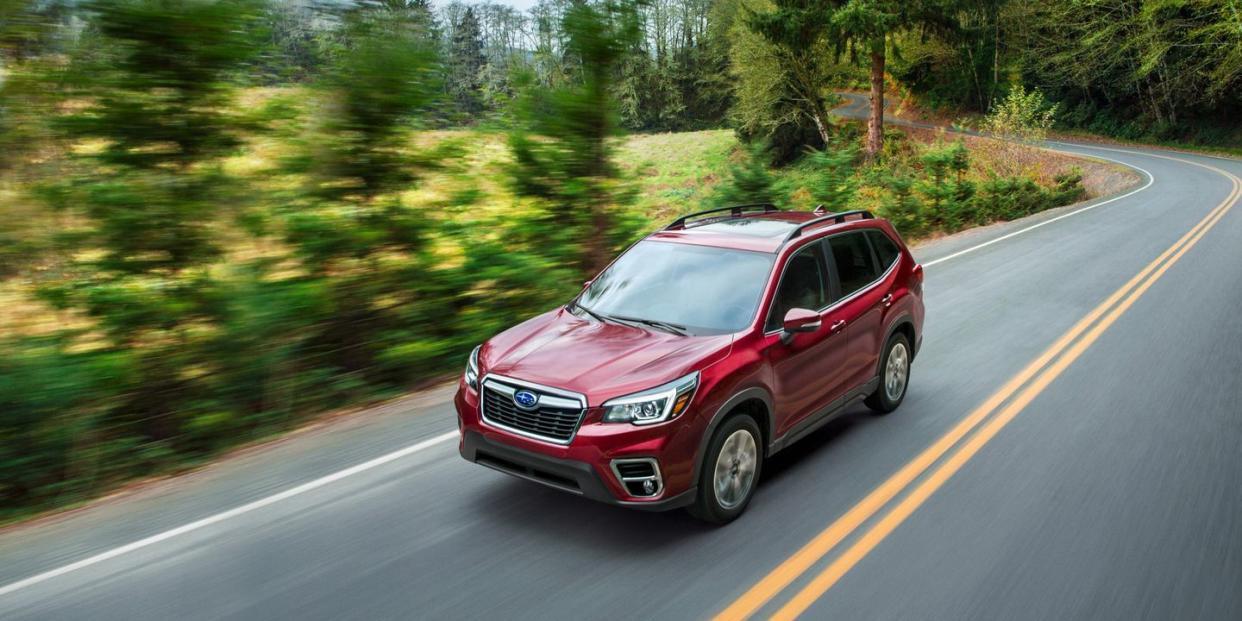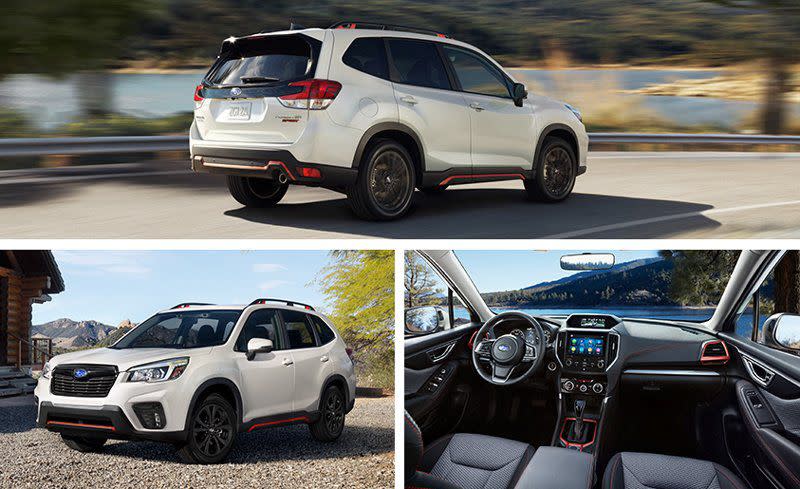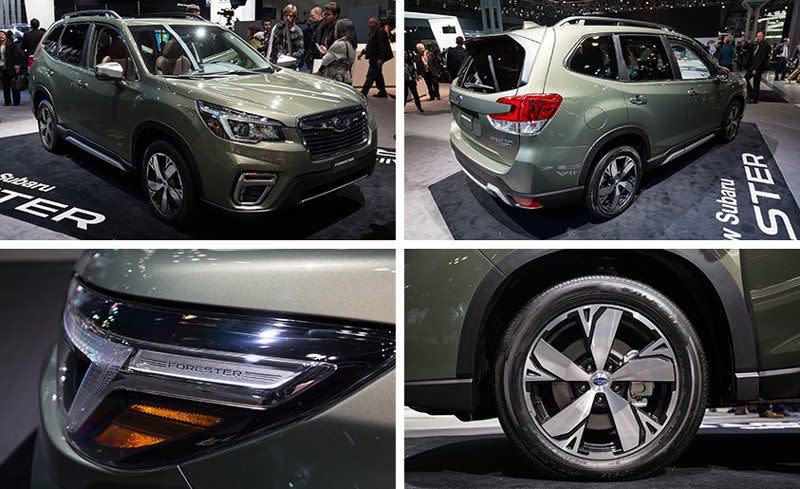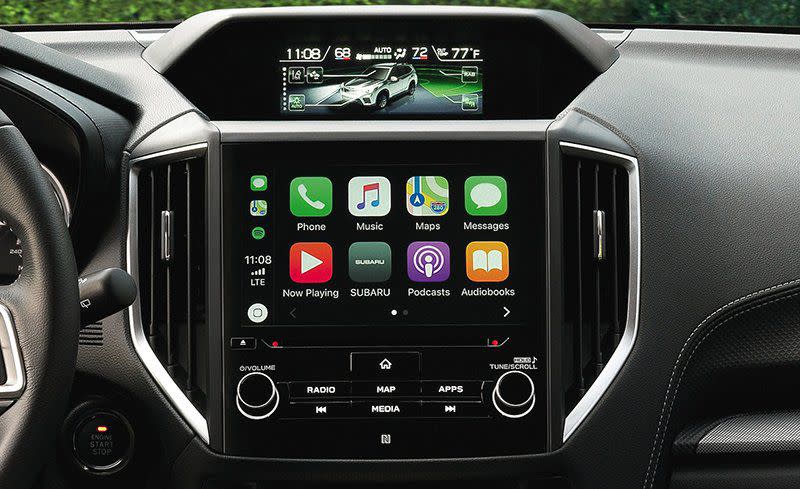2019 Subaru Forester: Playing to Its Base

Subaru and Bentley owners should get to know each other. The 2019 Forester and the 2019 Continental GT show common ground despite serving two drastically different demographics, in that their buyers prefer things to stay almost exactly the same. These are people who feel their cars were perfect the first time, who keep their cars a long time, and who would be unnerved if a new version changed everything they loved. Indeed, this all-new Forester hides its most significant innovations under a familiar-looking skin lest the Subaru base revolt and set their golden retrievers loose on a terrifying rampage. Or, worse, buy a Toyota.
More Standard, Less Speed
So, while this fifth-generation model rides on Subaru’s new Global Platform, the 2019 Forester’s slab-sided body panels look practically carryover from the 2018 version. The new platform is a stronger, lighter, and quieter foundation that already underpins the Impreza, Crosstrek, and Ascent. The only underhood offering is a revised version of the 2.5-liter flat-four engine paired with a continuously variable automatic transmission (CVT) and all-wheel drive. Subaru touts the boxer’s higher compression ratio and direct injection, which nudge horsepower to 182 (up 12 hp) and peak torque to 176 lb-ft (from 174). Manual and turbo enthusiasts are shunned, as Subaru has dropped both the 250-hp turbo 2.0-liter that powered the previous XT model and killed the six-speed manual transmission currently offered on the base and Premium trims. We hold out hope that the turbo 2.4-liter that’s debuting in the new three-row Ascent will eventually make its way into the Forester.
Subaru at least adds some performance-enhancing features as standard, including the Subaru Intelligent Drive (SI-Drive) throttle control and brake-based torque-vectoring system from the WRX. More to the point for core buyers, the Sport, Limited, and Touring models offer two snow settings that automatically modulate the front-to-rear torque split as well as the stability control, transmission shift points, and throttle mapping. Ground clearance remains a healthy 8.7 inches-more than that of many bigger SUVs-while the wheelbase stretches 1.2 inches.
Other standard features include LED headlights, auto stop/start, automatic climate control, an electronic parking brake, welcome lighting, and trailer-sway assist. A new Forester Sport takes over for the 2.0XT, but its special equipment is largely cosmetic. It features a grille with gloss-black trim, black 18-inch wheels, a roof spoiler, and touches of orange on the roof rails and rocker panels. Situated above the base and Premium trims and beneath the Limited and Touring, the Sport has the same 182-hp engine as other Foresters but does add a third Sport Sharp mode to the SI-Drive system for illusory performance.
Face-Recognition Time
A new 6.5-inch Starlink infotainment screen (up 0.3 inch) features Apple CarPlay, Android Auto, SiriusXM satellite radio, and apps, including Pandora, through a paired smartphone. Higher trims get an 8.0-inch touchscreen and TomTom navigation. Subaru’s optional Starlink connectivity service offers remote start, an on-call concierge, stolen-vehicle tracking, wireless updates, and parental monitoring features such as speed alerts and geofencing.
As in the Ascent, Subaru’s EyeSight bundle of camera-based driver assists also comes standard. It includes automated emergency braking, forward-collision alert, lane-keeping assist, and adaptive cruise control. Rear automated emergency braking and blind-spot monitoring are optional. The top Touring trim includes a new facial-recognition camera called DriverFocus, intended to monitor driver distraction. It can also store up to five different drivers’ individual settings for seat position, climate control, and the infotainment system.
Also at the Touring trim level, the Forester includes exterior mirrors that sync with the memory positions and can tilt down when the car is shifted into reverse. There’s also an eight-way power passenger seat and heated rear seats; and don’t overlook the map pockets with the handy dividers. Subaru is rather proud of such conveniences, although some are arriving many years after other brands have adopted them. The base Forester model continues with steel wheels and plastic wheel covers, although even many economy cars have switched to alloys.
Subaru knows its customers, though, and the Forester retains its thin pillars and large glass area-no small detail in light of tough safety requirements that have led many competitors to raise beltlines and increase the size of the A-pillars, which reduces visibility. Steeper angles for the C-pillars and the rear door openings make easier work of loading tots into car seats, while adult passengers enjoy an extra 1.4 inches of legroom. The Forester’s generous 76 cubic feet of rear-seats-folded cargo space grows by nearly two cubic feet, and the liftgate opening is 5.3 inches wider so a golf bag can fit “sideways without tilting it,” as the company says.
The 2019 Subaru Forester arrives at dealers later this year. Pricing rises a bit across the board, with the base 2.5i model starting at $25,270-$1560 more than before due to the fact that the CVT is now standard rather than optional-the 2.5i Premium at $27,670, the new Sport trim at $29,770, the Limited at $31,770, and the Touring at $35,270.
('You Might Also Like',)





